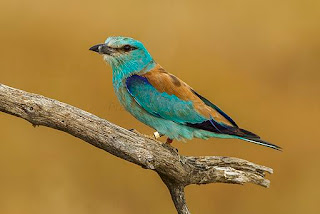The Eurasian roller (Coracias garrulus) is notable for the proportion of its life that it spends migrating between its breeding grounds in Europe (central and southern) and Asia and its winter quarters in southern Africa.
Appearance
About 12 inches in length, the Eurasian roller has the
general shape of a jay but is more highly coloured. The breast is bright blue,
the wings are a darker blue, and the back is bright chestnut.
The bird has a harsh and discordant call.
Habitat
The Eurasian roller prefers open countryside that contains
mature trees. It can also be seen in forest margins, old orchards and large
clearings.
Behaviour and feeding
The Eurasian roller is a carnivorous bird that feeds on
insects, invertebrates, small rodents and even other birds. It feeds by
swooping down from a high perch.
Breeding
Eurasian rollers reach their breeding grounds in late April
or early May, after which the males perform a courtship display that consists
of plunges and aerobatics accompanied by loud calling.
Nests are built in hollow trees or holes in river banks. Up
to seven eggs are laid, these being incubated by both parents for 17-20 days.
Migration
At the end of Summer the Eurasian roller begins its journey
south, flying around 40 miles a day and taking frequent breaks before reaching
East Africa by late October or early November, and South Africa in early
December. The return flight is started in February. It is therefore settled in
one place for a relatively short time.
© John Welford

No comments:
Post a Comment